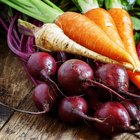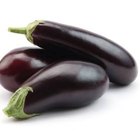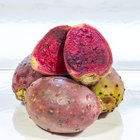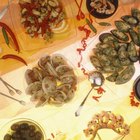denizya/iStock/GettyImages
When the fleeting season for a perfect peach finally arrives, you may be tempted to take a long-anticipated bite and feel the succulent juice run down your arm -- along with chlorpyrifos, fludioxonil, vinclozolin and possibly an E. coli cell or two. Nearly 70 percent of conventionally grown fruits and vegetables contain pesticide residue, according to tests conducted by the U.S. Department of Agriculture. While the U.S. Food and Drug Administration recommends a thorough rinse in cold tap water as the best way to remove surface pesticides and bacteria, a quick dunk in diluted household vinegar may provide an extra level of protection.
Smooth-Skinned Fruits and Vegetables
Rinse any visible dirt from the fruits and vegetables under cold running tap water.
Fill a large bowl or pot with cold tap water. Add distilled white or apple cider vinegar in a ratio of one part vinegar to three parts water.
Dunk whole fruits and vegetables with smooth skins, such as apples, pears, stone fruits, cucumbers, potatoes and tomatoes, one at a time in the vinegar solution. Swish them around for about 10 seconds.
Scrub tough-skinned fruits and vegetables such as apples, potatoes and cucumbers with a dedicated vegetable brush if you intend to eat the skin or peel.
Rinse each piece of fruit or each vegetable individually in a stream of cold tap water for 10 seconds.
Set each piece of fruit or vegetable on a clean towel to dry or dry them immediately with a soft, clean cloth.
Leafy Greens and Other Cruciferous Vegetables
Remove the outer leaves from a head of leafy greens, cauliflower or broccoli.
Separate the remaining leaves and rinse away any visible dirt in cold running water. Rinse the cauliflower or broccoli whole.
Fill a large bowl or pot with cold tap water. Add distilled white or apple cider vinegar in a ratio of one part vinegar to three parts water.
Dunk the head of leafy greens or the whole head of broccoli or cauliflower in the vinegar solution. Let it soak for up to two minutes.
Rinse the leaves individually in cold running water and set them on a clean towel to dry. Rinse the head of broccoli or cauliflower in cold running water and set it in a colander to dry.
Related Articles

How to Clean Ray-Bans

How to Peel Raw Beets
How Do I Clean Water Cress?

How to Wash Kanekalon

Vinegar Wash on Berries

How to Sterilize Body Jewelry

How to Clean a Philips Norelco Shaver

Fresh Homemade Orange Juice Will Stay ...

How to Wash Wax Off of Vegetables
How to Blanch Red Potatoes for Peeling

How to Remove Hair Dye Stains

How to Clean Eggplant

How to Whiten Natural Nails

Peeling the Spiny Chayote Squash

How to Disinfect Sunglasses

How to Make Prickly Pear Juice

How to Get Rid of Yellow Age Spots on ...

How to Clean Soft-Shell Clams (Steamers)

How to Get Clumps Out of Eyelashes
How to Juice Beet Stalks
References
- U.S. Food and Drug Administration: How Does FDA Recommend Washing Fruits and Vegetables?
- NPR: What Does It Take to Clean Fresh Food?
- Colorado State University Extension: Preventing E. coli From Garden to Plate
- Environmental Working Group: Frequently Asked Questions About Produce and Pesticides
- University of Kentucky: Id-93: Chapter 6: Orchard Pesticides
- Chicago Tribune: Pesticides in Your Peaches
Tips
- Organic fruits and vegetables can carry potentially harmful bacteria, so clean them carefully as you would any conventionally grown produce. The editors of "Cook's Illustrated" magazine found that a vinegar rinse removed 98 percent of bacteria from the surface of fruits and vegetables.
Warnings
- Delicate fruits such as berries don't fare well with the vinegar rinse method.
- Bad bacteria like to cluster around the drain of your kitchen sink, so soaking fruits and vegetables there can easily spread those bugs around, leaving more on your fruits and vegetables than they had when you brought them home. For safety, use a large bowl or pot.
Writer Bio
Since landing her first journalism job editing a small-town weekly in 1992, Deb Barracato has written for and edited newspapers, regional magazines, books and online publications. She holds a bachelor's degree in journalism from University of Maryland.